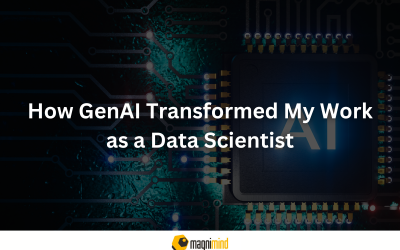As businesses started to know and appreciate the power of data and the insights data provides, many tools, techniques, and jobs have been created to analyze and process data. While the ultimate goal is to produce actionable insights from that data, the tech world is getting filled with a significant number of technical terms. Data science and data mining are two names on the list. In this blog post, we’ll cover in detail what data science and data mining means and how they differ. We will also discuss what value these two can provide to the businesses.
What is Data Science?
The term data science can be traced back to 1974, when Naur proposed it as an alternative name for computer science. Later in the coming years, it was also called data analytics unless Chikio Hyashi suggested that data science should be an entirely different field of study encompassing the aspects of data design, data collection, and data analysis. The popularity and significance of data science surged with the advent of big data in the early 21st century. The exponential growth of data and the need to extract valuable insights from it led to the emergence of Data Science as a distinct field.
Data Science is an interdisciplinary field that uses a combination of devices, algorithms, and machine learning principles to analyze structured and unstructured data and derive valuable insights from it. Data Science also uses principles of statistics, data analytics, and modeling to comprehend the complex world of data.
Data scientists are responsible for gathering the data, analyzing it, and connecting the obtained information and insights in such a way that positively influences business decisions.
What is Data Mining?
Data mining is extracting valuable patterns, trends, and information from unstructured data. It involves the partitioning of data and calculating the probability of future events. Data mining is used by retail companies and financial organizations to identify trends to increase customer base, predict the fluctuation in stock prices and customer demand, etc.
Data mining can help organizations in several ways, from predicting customer behaviors to fraud prevention and spam filtering. Data mining can be performed with the help of special programs or software that break down connections and patterns in data based on which information users request or provide.
Data Science vs. Data Mining: Key Differences
Imagine you are a gold miner looking for valuable nuggets. Data mining is comparable to using a shovel to find a gold nugget and extract it. In other words, data mining is examining large datasets to discover the underlying patterns and trends.
Now imagine that you are a metallurgist who finds gold and other metals, assesses their quality, and determines how they can be utilized. This is comparable to data science which encompasses all aspects of data science, including gathering, analyzing, cleaning, and visualization.
Let’s dive deeper and see how these two fields differ.
The Terms- Data Science and Data Mining
Data Science is the broader term that involves gathering data, cleaning, validating, and obtaining valuable insights. It is a multidisciplinary field applying the principles of mathematics, statistics, computer science, domain expertise, data visualization, and data mining.
Data mining is a relatively narrower field that finds hidden patterns in large data sets for predicting future trends and other purposes. Data mining uses statistical analysis to determine underlying insights with traditional methods that may not be visible.
Objectives
As previously discussed, data science analyzes data to obtain meaningful and valuable insights to help businesses make better decisions. The goal of data science is usually to build the dominance of a product. The purpose of data science is to create data-centric projects. Data scientists explore, sort, and analyze data that helps businesses in decision-making.
On the other hand, the objective of data mining is to find existing data properties that were not known previously. Data mining aims to make the data we already have more helpful. Data analysts extract only valuable information from large amounts of data sets and organize it to discover meaningful patterns and structures.
Applications
Data science has scientific applications performed for a project program or portfolio-centric analysis. Some of the major applications of data science are as follows:
- Fraud and risk detection in financial systems.
- Targeted Advertisement
- Data Management in Healthcare
- Personalized recommendations in entertainment
- Advanced Image Recognition
- Airline Route Planning
Data mining, on the other hand, is used mainly in business applications. Organizations create operational marketing and financial strategies based on the data gleaned from data mining. Some of the real-world applications of data mining include:
- Market analysis for understanding market risks and predicting future trends
- Financial analysis
- Inspecting the performance of students in higher education
- Fraud detection
Data
- Data science deals with all kinds of unstructured, semi-structured, or structured data including text, images, videos, sensor data, and more.
- Data mining deals with only structured data in databases, spreadsheets, or tables.
Steps Involved
Noting the steps involved in both technologies will give you a clearer understanding of their differences.
The steps involved in data science are:
- Accumulating the data from various sources (data collection from APIs, databases, web scraping, and IoT devices)
- Wrangling the data, i.e., cleaning and converting data into a more helpful format for obtaining maximum output.
- Analyzing the data using statistical models and analytics.
- Visualizing the data, i.e., using visuals to convey data effectively
- Using data for making predictions and decision making
- Recapitulating the data
The steps involved in the process of data mining are as follows:
- Cleaning the data to remove irregularities
- Integration of data from various sources
- Selection of useful data
- Conversion of data into more understandable formats
- Mining the data using associative analysis and clustering techniques etc.
- Evaluating the data
- Using the data for various purposes
Conclusion
In conclusion, data science is a broader field that encompasses a more comprehensive set of activities, including data gathering, cleaning, analysis, and visualization for gaining valuable insights for decision-making and project-centric research. On the other hand, data mining is usually concerned with extracting hidden patterns and trends from structured data.
Data mining can be considered as a subset of data science. Data science is generally concerned with scientific applications, while data mining is used in market analysis, financial analysis, fraud detection, etc. By understanding the difference between these two, businesses and organizations can leverage them to get the most value out of their data.
. . .
To learn more about data science, click here and read our another article.


